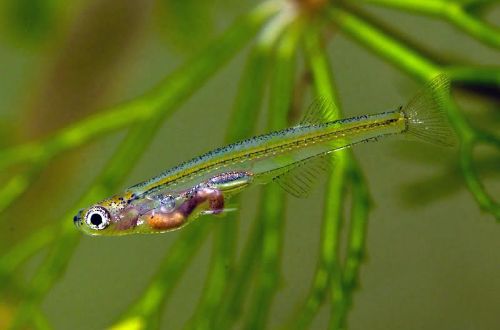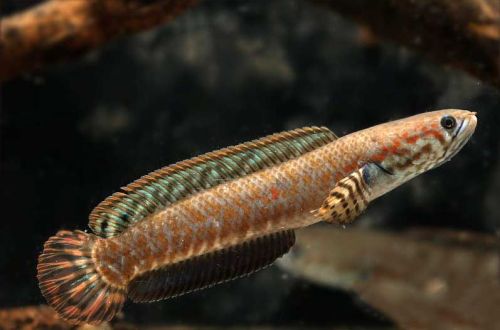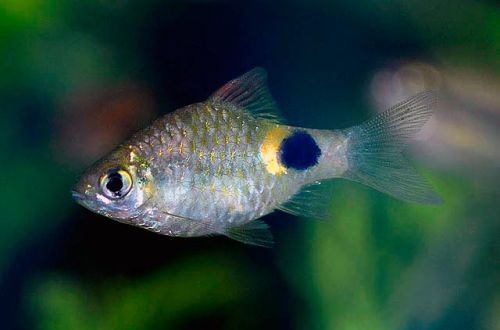
Greenstriped Barbus
The green-striped barb, scientific name Puntius vittatus, belongs to the family Cyprinidae (cyprinids). Easy to keep and breed, compatible with most other peaceful species. In the aquarium trade, it is quite rare compared to other Barbs, mainly due to its modest coloration.

Contents
Habitat
It is widely distributed throughout the Hindustan Peninsula and partly throughout Pakistan. They inhabit flat water bodies with a slow current and silty substrates: tributaries of large rivers, backwaters, canals, wetlands, and rice fields. It is worth noting that some scientists hold a different point of view about the natural habitat, significantly reducing it, and explain this by the fact that several closely related species fall under one name.
Brief information:
- The volume of the aquarium – from 60 liters.
- Temperature – 18-26°C
- Value pH — 6.0–7.5
- Water hardness – soft (2-12 dGH)
- Substrate type – any
- Lighting – subdued
- Brackish water – no
- Water movement – light or moderate
- The size of the fish is about 4.5 cm.
- Feeding – any food of suitable size
- Temperament – peaceful
- Keeping in a group of 6-10 individuals
Description
Adult individuals reach a length of about 4.5 cm. The color of males is gray with a green tint, which is most noticeable above the lateral line. Females are silvery without obvious green tints. The base of the tail and dorsal fin are patterned with a black stroke/spot on a red background.
Food
Not picky about the composition of food. In a home aquarium, the diet can consist exclusively of dry quality food (flakes, granules). The inclusion in the diet of live or frozen foods in the form of bloodworms, artemia is only welcome.
Maintenance and care, arrangement of the aquarium
The optimal size of the tank for a small cod of fish starts from 60 liters. The choice of design is not critical, however, the presence of dense thickets of plants, including floating ones, and dark soil contribute to the manifestation of a brighter color. For example, in a half-empty aquarium in bright light, the green hues of the fish are lost.
Keeping a Greenstriped Barb will not cause trouble even for a novice aquarist, if a number of mandatory but standard procedures are followed: weekly replacement of part of the water with fresh water, regular cleaning of organic waste, monitoring of the main hydrochemical indicators (pH and dGH) and preventive maintenance of equipment.
An important, and perhaps key, role in maintaining stable water conditions is the filtration system. When choosing a filter, it is recommended to give preference to models that do not cause excessive movement of water, since the fish are not adapted to strong currents.
Behavior and Compatibility
Peaceful and accommodating fish, goes well with other species of comparable size, natives of the same habitat (Asia, Southeast Asia). Good compatibility is also possible with representatives from other continents, for example, haracins. To keep the fish in good shape, it is advisable to acquire a flock of at least 8-10 individuals.
Breeding / breeding
They show a typical breeding strategy for most cyprinids. During the spawning period, females scatter hundreds of eggs in the water column, and males fertilize them. Parental instincts are not developed, therefore, immediately after spawning, adult fish, on occasion, will certainly eat their own eggs and fry that have appeared. Therefore, in the conditions of a common aquarium, the survival rate of juveniles is extremely low.
If you plan to keep the entire brood, or at least a significant part of it, then you will need to prepare a separate tank in advance, something like a spawning aquarium, with identical temperature, pH and dGH values. Usually this is a small container, even a three-liter jar equipped with a simple airlift filter with a sponge and a heater will do. A separate light source is not required, the light coming from the room is enough. As decoration, you can use artificial plants or shade-loving mosses or ferns.
During the spawning period, the eggs are carefully moved to the spawning aquarium. The incubation period lasts about 24-48 hours. After another day, they begin to swim freely. At first, feed microscopic food such as shoe ciliates. After a week, they can eat Artemia nauplii and other microfeed.
Fish diseases
In a balanced aquarium ecosystem with species-specific conditions, diseases rarely occur. Diseases are caused by environmental degradation, contact with sick fish, and injuries. If this could not be avoided, then more about the symptoms and methods of treatment in the section “Diseases of aquarium fish”.





